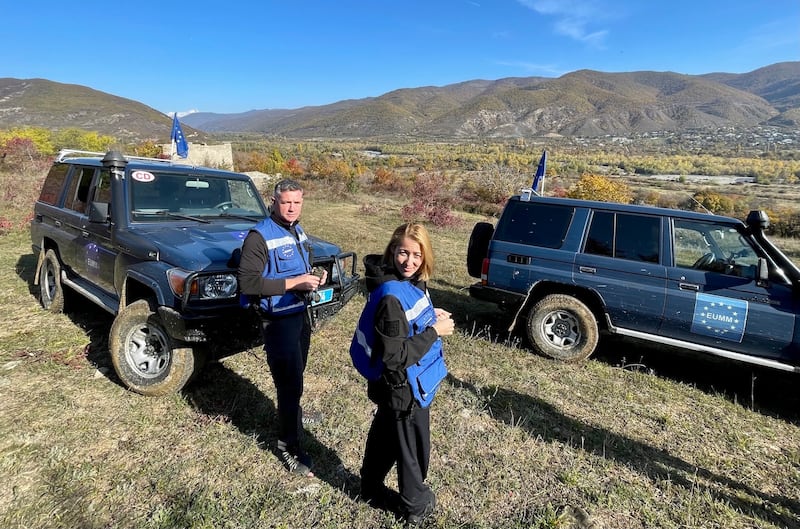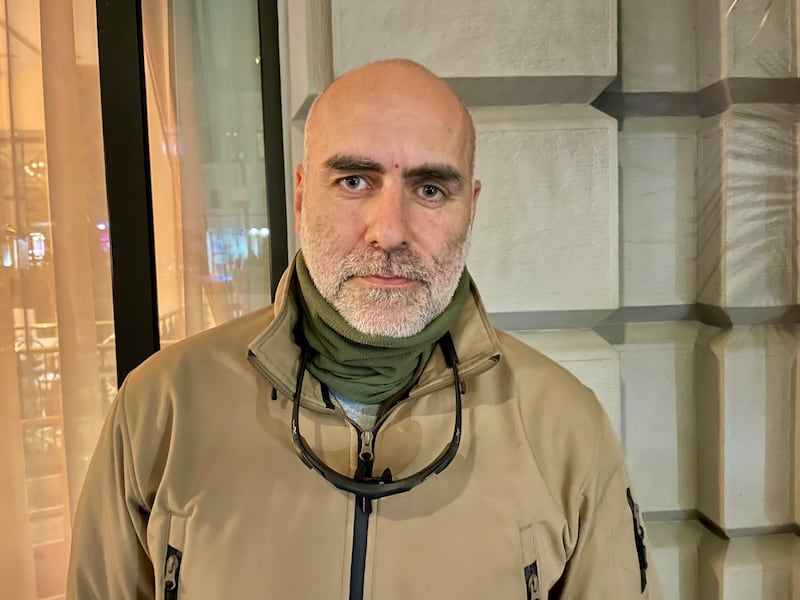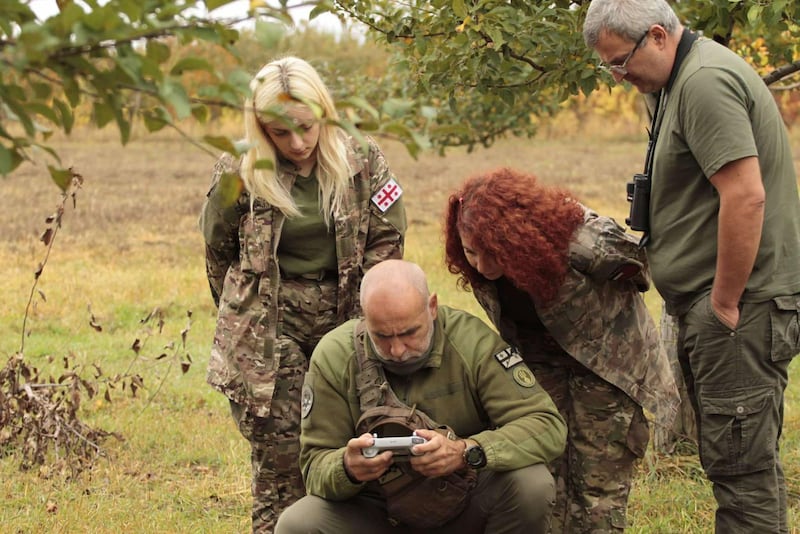On most world maps there will be no international border beside the tiny Georgian village of Tvaurebi, yet its abandoned fields are cut by a high metal fence and rolls of barbed wire backed by security cameras, motion sensors and tripwires.
On a bank of the glinting Ksani river stands a green watchtower and less than 2km away are the red roofs of a modern base built for Russian border guards who patrol this area. A sign behind the security fence states the name that only Moscow and a few allies around the world use for this territory: the Republic of South Ossetia.
Russia helped South Ossetian militia break from Georgia’s rule after the collapse of the Soviet Union in 1991 and propped up their regime until full-scale fighting over the region erupted in 2008, prompting a brief Russian invasion of Georgia and the Kremlin’s recognition of the province as an independent state. A similar scenario with the same outcome played out in another Georgian region, Abkhazia, on the Black Sea coast.
The wars left Georgia with 300,000 internally displaced people, a fifth of its territory occupied by Russian troops who guard the breakaway regions, and two de facto internal borders – officially called administrative boundary lines (ABLs) – where the chilling effect of these “frozen conflicts” seeps through every aspect of local life.
“The security situation is stable but also volatile, it can change at any moment ... and the local population still feels quite a strong impact from the conflict,” says Juulia Baer-Bader, a spokeswoman for the European Union Monitoring Mission (EUMM) that has worked along the South Ossetia and Abkhazia ABLs since 2008.
Russia has built fences on stretches of the partition lines, dividing fields and orchards where locals and livestock roamed freely for generations. To retrieve an errant cow or harvest fruit on the South Ossetian side of the line is to risk capture by Russian troops, detention of at least a few days and potential mistreatment; last November, a Russian soldier shot dead a Georgian man at a disputed church on the ABL.
“The overall trend [of detentions] has been decreasing over the years. It’s a good sign but for the wrong reason – because there is more physical ‘borderisation’ people cannot cross the line, or they are intimidated because they have a family member or friends who were detained,” Baer-Bader says.
“It’s difficult,” adds Declan Gannon, the Castlebar man who is the EUMM’s acting head of operations. “There are two official crossing points pretty much at either end the South Ossetia ABL, but for people living in the middle – as most do – it’s incredibly hard to get to those crossings.”

Gannon says the EUMM’s permanently open hotline for resolving issues across the ABLs around South Ossetia and Abkhazia took some 2,500 calls last year, on everything from stray livestock and water access problems to detentions and emergency trips to Tbilisi, Georgia’s capital 90km to the south, for medical treatment.
The official crossings are usually open for 10 days a month but were closed in advance of Georgia’s parliamentary election last Saturday for security reasons, according to Russian-backed officials in South Ossetia and Abkhazia.
Opposition figures suspect it was a ruse to prevent Georgians living in occupied areas from voting for parties other than the governing Georgian Dream, which has made stabilising relations with Moscow one of its priorities.
Bidzina Ivanishvili, who made his fortune in Russia before returning home and founding Georgian Dream in 2012, angered many compatriots recently by saying Georgia should apologise to South Ossetia for the 2008 war, which he claims was started by former president Mikheil Saakashvili and his allies at home and abroad.
Saakashvili is now in a Tbilisi jail on abuse of power charges that he dismisses as political persecution, and his United National Movement is the biggest of a host of opposition parties that accuse Georgian Dream of rigging the election and moving the country of 3.7 million away from the West and towards Russia and autocracy.
Georgian Dream’s main campaign message was that victory for the opposition would plunge the nation back into war with Russia, while the continuation of its own rule would ensure peace, stability and progress towards eventual EU membership.
However, Brussels says the prospect of accession is jeopardised by democratic “backsliding” in Georgia, where the government has restricted LGBT+ rights, tightened control over civil society groups and ramped up anti-western rhetoric – all signs, critics say, of growing Russian-style rule.
“Russia’s creeping occupation didn’t stop for a day,” says David Katsarava, a prominent activist and leader of a group called Strength in Unity, whose volunteers have been independently monitoring areas near South Ossetia and Abkhazia since 2017.

“The government is trying to assure society that [the conflict] is frozen and nothing is happening there. But every day something is happening. The Russians have plans to add additional territories to the occupied part of Tskhinvali region and they are kidnapping our citizens and beating and torturing them and killing them,” he adds, using an alternative Georgian name for the South Ossetia area. “This is a war – not in a hot phase but a hybrid phase – and we are losing our territories.”
As Katsarava drinks coffee in a Tbilisi cafe, several passersby stop to offer handshakes and expressions of support. He is also an actor, but says he is now best known for his efforts to keep attention on a major security issue that he accuses the government of trying to bury as it improves ties with Moscow. Many people were also shocked by a brutal beating he received at police hands during a protest rally in May.
“Lots of people have land plots on the occupation line. Working on their land and in their yards, they are always in danger of being kidnapped by the Russians,” he says.
“This contributes to depopulation of the territory. People are living there in fear. I hear many times that people don’t want to go back to their land, because it could mean being taken to the other side to a Russian military base, and Tskhinvali jail is not a holiday,” Katsarava adds. “This is terror. And there is absolutely no protection from the state.”

Under a deal to end the 2008 fighting, Georgia and Russia agreed to return their forces to pre-war positions. There are now no Georgian soldiers near the South Ossetia and Abkhazia ABLs, while Russia keeps thousands of troops in both areas.
“Three of the four Georgian districts around South Ossetia are absolutely unsecured, except for some police at the two official crossing points,” says Katsarava, whose teams use drones and other equipment to monitor Russia’s military build-up in occupied areas. “People are living there unsecure and face-to-face with the Russians,” he adds.
The Strength in Unity volunteers venture into what Katsarava calls “fear zones” – areas where local people and Georgian police dare not go due to the danger of meeting Russian troops.
“It’s very risky but if we don’t go there then the Russians will think it’s already their territory,” Katsarava says. “We raise awareness in Georgian society and attract a lot of attention to this issue – and Russia and Georgian Dream want there to be silence.”
- Sign up for push alerts and have the best news, analysis and comment delivered directly to your phone
- Find The Irish Times on WhatsApp and stay up to date
- Our In The News podcast is now published daily – Find the latest episode here





















